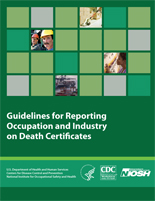 The National Institute for Occupational Safety and Health (NIOSH) has revised guidelines designed to help funeral directors complete the Decedent’s Usual Occupation and Kind of Business/Industry items on electronic and paper death certificates.
The National Institute for Occupational Safety and Health (NIOSH) has revised guidelines designed to help funeral directors complete the Decedent’s Usual Occupation and Kind of Business/Industry items on electronic and paper death certificates.
“By reporting accurate data on industry and usual or life-time occupation of decedents, funeral directors and those involved in the registration process are helping to improve statistics on occupational mortality and worker health,” according to NIOSH.
The original guidelines were written in 1988 by the National Center for Health Statistics (NCHS) (DHHS Publication No. 88-1149).
NIOSH reviews the quality of the occupation and industry reported, combines it with the NCHS mortality data, and reports U.S. occupational mortality trends.
With the average U.S. worker spending a substantial part of his or her life at work, workplaces or jobs may expose workers to risks or hazards that can contribute to injury or disease. Information about an individual’s job and type of business provides a snapshot of the hazards he or she might have encountered on the job. Disease may appear immediately or many years after the worker left the job.
The data on the occupation and industry of workers can point to health risks to which the workers may have been exposed. In the United States there are approximately 5,000 traumatic work-related fatalities and tens of thousands of work-related deaths from illnesses reported each year. It has been known for many decades that exposures to hazards in the work environment can cause severe injury or illness and death in workers.
“It is important to collect high quality, accurate, and complete responses on the death certificate for all decedents over age 14 that were ever employed, unemployed, or retired,” says NIOSH. “Such data can be used for making decisions on creating safer and healthier work environments.”



